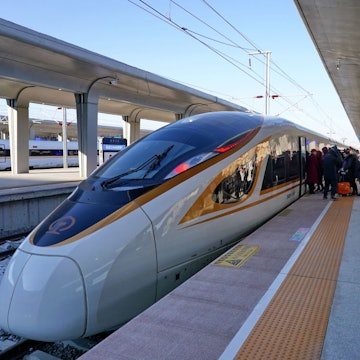

China's trains offer a highlight reel of the nation's best sights – soaring Himalayan peaks, bamboo forests, ancient temples and remote deserts © linlypu/Shutterstock
A nation of vast distances and ever-changing landscapes, China is a destination that’s simply made for train travel. While you’ll encounter the classic imagery of the country’s mist-shrouded jagged peaks and pine-clad temples, you may be surprised by what else is on offer.
From the snow-capped Himalayas and Silk Road oasis towns to grassy Inner Mongolian steppes and bamboo forests, China’s expansive rail network gets you right in amongst it – reaching speeds in excess of 300km/h, the arrival of the fast-train network has been a game changer. Not only has it halved the time required to travel across the country, but it’s infinitely more comfortable and reliable, and offers a much greener alternative to flying. And with the unveiling of the Maglev bullet trains, clocking in around 600km/h, rail travel is about to get even faster.
Here are our picks for the best train journeys running through China, to see beautiful landscapes, epic World Heritage sites and beyond.

Beijing to Lhasa (3757km)
One of China’s most epic train journeys is this spectacular two-day trip along the highest railway line in the world. Running from the nation’s capital all the way to Tibet, it covers some 3757km across eight provinces.
Departing Beijing in the evening, you’ll awake to the flat rural landscapes of the North China Plain, but it’s not until reaching Qinghai (2275m) that the highlights reel clicks into gear. Here you’ll pass through the Tibetan Plateau as you make your ascent to the Roof of the World. The remaining 1110km to Lhasa features 86% of the line above 4000m; the highest point is at Tanggu-la Pass (5072m), the highlight, where you’ll be treated to the sharp-contoured snowy mountains overlooking stunning grasslands home to Tibetan nomads and yaks.
And for those wanting to make the trip in luxury, the Golden Eagle Shangri-La Express does the journey too.

Trans-Mongolian (7621km)
No discussion on China train travel is complete without mention of the Trans-Mongolian route. One of the world’s great rail journeys, this seven-day, six-night bucket-list adventure travels 7621km from Beijing into the wilds of the Gobi desert, the Mongolia steppe and the endless birch forests of Siberia before pulling into Moscow.
Departing from Beijing, the Chinese leg takes you through the dramatic forest mountain scenery of Northern China's Hebei and Shandong provinces before entering the grass steppes of Inner Mongolia. Reaching the Mongolia border, you’ll encounter the remarkable process of the changing of the bogies, in which each carriage is painstakingly hoisted up to change the gauge from the Chinese to Russian line before continuing on its way.
Another option from Beijing is the Trans-Manchurian (8986km). This less-traveled journey takes you through China’s northeast provinces before arriving at Harbin, from where it shoots through Inner Mongolia to reach the Russian border and on to Moscow.
Hefei to Fuzhou (850km)
Unquestionably one of China’s most scenic high-speed railways, this route passes not one, but three World Heritage sites. Beginning in Hefei in Anhui province, this bullet train races through China’s southeast to arrive at Fuzhou in Fujian province. It’s a four-hour journey through mountainous scenery of mist-cloaked pine forest, canyons, rivers, tea plantations and well-preserved villages. Highlights include Huangshan, Sanqingshan National Park and Mt Wuyi, all featuring idyllic trails leading to summits with astonishing lookouts.
Xian to Urumuqi (2344km)
Linking China to the West, the ancient trade route of the Silk Road has long evoked a sense of romance for travelers far and wide. And though the days of camel-drawn caravans are long gone, the Lanzhou–Xinjiang High Speed Train enables you to retrace their steps in quicker and more comfortable means.
Boarding the train at the Silk Road’s historical starting point in Xi'an, you’ll shoot through the plains of Shaanxi province to arrive at Lanzhou in Gansu. Here you’ll transfer to another bullet train to Xinjiang province, from where you’ll pass through China’s northwest wilderness, admiring the Gobi Desert, grasslands and snow-capped mountains among the rapid-fire development of new cities. Arriving at the provincial capital of Ürümqi, you’ll notice a distinct exotic flavor that feels more Central Asia than mainland China.

Guiyang to Guangzhou (856km)
If ever there was an example of just how much China’s fast-train network has made a difference, then the route between Guangzhou and Guiyang is it. Back in 2014, it took 20 hours; today it takes little more than four.
Beginning in Guiyang, the train travels southeast through Guangxi’s attractive verdant valleys to reach Guilin and Yangshuo, with its famous karst limestone peaks. Jutting out like sharp mossy teeth that span the horizon, it’s as spectacular as it is surreal; so otherworldly, in fact, it was used as the backdrop to the Wookiee planet Kashyyyk in Star Wars: Revenge of the Sith. You’ll pass among its rice fields and the scenic Li River before crossing into the Cantonese province of Guangdong to arrive at Guangzhou – one of China’s biggest and most dynamic cities.
You may also like:
The most epic overnight train journeys in the world
Great Wall: get to know China's most iconic structure
How to plan your dream trip to the Himalayas













